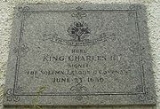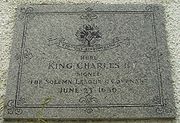
Solemn League and Covenant
Encyclopedia


Scotland
Scotland is a country that is part of the United Kingdom. Occupying the northern third of the island of Great Britain, it shares a border with England to the south and is bounded by the North Sea to the east, the Atlantic Ocean to the north and west, and the North Channel and Irish Sea to the...
Covenanter
Covenanter
The Covenanters were a Scottish Presbyterian movement that played an important part in the history of Scotland, and to a lesser extent in that of England and Ireland, during the 17th century...
s and the leaders of the English
England
England is a country that is part of the United Kingdom. It shares land borders with Scotland to the north and Wales to the west; the Irish Sea is to the north west, the Celtic Sea to the south west, with the North Sea to the east and the English Channel to the south separating it from continental...
Parliamentarians
Roundhead
"Roundhead" was the nickname given to the supporters of the Parliament during the English Civil War. Also known as Parliamentarians, they fought against King Charles I and his supporters, the Cavaliers , who claimed absolute power and the divine right of kings...
. It was agreed to in 1643, during the First English Civil War
First English Civil War
The First English Civil War began the series of three wars known as the English Civil War . "The English Civil War" was a series of armed conflicts and political machinations that took place between Parliamentarians and Royalists from 1642 until 1651, and includes the Second English Civil War and...
.
The Protestant leaders of the embattled English parliament, faced with the threat of Irish Catholic
Irish Catholic
Irish Catholic is a term used to describe people who are both Roman Catholic and Irish .Note: the term is not used to describe a variant of Catholicism. More particularly, it is not a separate creed or sect in the sense that "Anglo-Catholic", "Old Catholic", "Eastern Orthodox Catholic" might be...
troops joining with the Royalist
Cavalier
Cavalier was the name used by Parliamentarians for a Royalist supporter of King Charles I and son Charles II during the English Civil War, the Interregnum, and the Restoration...
army, requested the aid of the Scots. The Presbyterian Covenanters promised their aid against the 'papists', on condition that the Scottish system of church government was adopted in England. This was acceptable to the majority of the English Long Parliament
Long Parliament
The Long Parliament was made on 3 November 1640, following the Bishops' Wars. It received its name from the fact that through an Act of Parliament, it could only be dissolved with the agreement of the members, and those members did not agree to its dissolution until after the English Civil War and...
, as many of them were presbyterians, while others preferred allying with the Scots to losing the Civil War.
After some haggling a document called the "Solemn League and Covenant" was drawn up. This was practically a treaty between England and Scotland for the preservation of the reformed religion in Scotland, the reformation of religion in England and Ireland "according to the word of God and the example of the best reformed churches," and the extirpation of popery and prelacy. It did not explicitly mention presbyterianism, and included some ambiguous formulations which left the door open to the English Independents, another strong faction on the English Parliamentary side, particularly in the parliamentary armies. It was subscribed to by many in England, Scotland, and Ireland, approved by the English Long Parliament, and, with some slight modifications, by the Westminster
Westminster
Westminster is an area of central London, within the City of Westminster, England. It lies on the north bank of the River Thames, southwest of the City of London and southwest of Charing Cross...
Assembly of Divines. This agreement meant that the Covenanters sent another army south to England to fight on the Parliamentarian side in the First English Civil War. Not all those on the parliamentarian side were happy with this arrangement and some, like John Lilburne
John Lilburne
John Lilburne , also known as Freeborn John, was an English political Leveller before, during and after English Civil Wars 1642-1650. He coined the term "freeborn rights", defining them as rights with which every human being is born, as opposed to rights bestowed by government or human law...
, choose to leave the parliamentary armies rather than take the oath prescribed in the Act enforcing the Solemn League and Covenant.
After the Royalists had lost the First Civil War, Charles I
Charles I of England
Charles I was King of England, King of Scotland, and King of Ireland from 27 March 1625 until his execution in 1649. Charles engaged in a struggle for power with the Parliament of England, attempting to obtain royal revenue whilst Parliament sought to curb his Royal prerogative which Charles...
was able to enter into an "Engagement
Engagers
The Engagers were a faction of the Scottish Covenanters, who made "The Engagement" with King Charles I in December 1647 while he was imprisoned in Carisbrooke Castle by the English Parliamenterians after his defeat in the First Civil War....
" with the majority of the Covenanters in which the Covenanters agreed to support Charles in the Second English Civil War
Second English Civil War
The Second English Civil War was the second of three wars known as the English Civil War which refers to the series of armed conflicts and political machinations which took place between Parliamentarians and Royalists from 1642 until 1652 and also include the First English Civil War and the...
against their mutual enemy the English Independents, in return for him imposing presbyterianism for three years on England. In 1648 the Royalists and the Covenanters were defeated at the Battle of Preston
Battle of Preston (1648)
The Battle of Preston , fought largely at Walton-le-Dale near Preston in Lancashire, resulted in a victory by the troops of Oliver Cromwell over the Royalists and Scots commanded by the Duke of Hamilton...
, and Charles was executed in January 1649. The Scottish Covenants persuaded the exiled Charles II of England
Charles II of England
Charles II was monarch of the three kingdoms of England, Scotland, and Ireland.Charles II's father, King Charles I, was executed at Whitehall on 30 January 1649, at the climax of the English Civil War...
to agree to the terms of the Solemn League and Covenant in the Treaty of Breda (1650)
Treaty of Breda (1650)
The Treaty of Breda was signed on 1 May 1650 between Charles II and the Scottish Covenanters during the Wars of the Three Kingdoms.-Background:...
. However the defeat of the Royalist and Scottish army at the Battle of Worcester
Battle of Worcester
The Battle of Worcester took place on 3 September 1651 at Worcester, England and was the final battle of the English Civil War. Oliver Cromwell and the Parliamentarians defeated the Royalist, predominantly Scottish, forces of King Charles II...
in 1651 ended the relevance of the Solemn League and Covenant as the power of the Presbyterians was broken on both sides of the border.
After the Restoration
English Restoration
The Restoration of the English monarchy began in 1660 when the English, Scottish and Irish monarchies were all restored under Charles II after the Interregnum that followed the Wars of the Three Kingdoms...
the English Parliament passed the Sedition Act 1661, which declared that the Solemn League and Covenant was unlawful, was to be abjured by all persons holding public offices, and was to be burnt by the common hangman.
External links
- The Solemn League and Covenant British Civil Wars website

